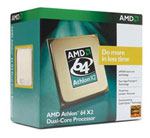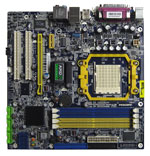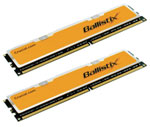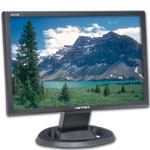AMD Entry-level PC
With few releases for the entry-level AMD market since our last
Budget Buyer's Guide, we have a very similar level of components - albeit with a doubling of RAM that should boost performance nicely in Vista. This boosted performance comes in at $100 cheaper than six months ago as well. Although that may not sound like much to an enthusiast gamer that can spend five times as much on a graphics card, for the budget computer users $100 is a 10% reduction in price. For businesses looking at upgrading hundreds or even thousands of computers, that sort of savings is even more significant, making now a great time to purchase AMD hardware.
| AMD Entry-level PC |
| Hardware |
Component |
Price |
Rebates |
| Processor |
AMD Athlon 64 X2 4000+
(2.1GHz 65W Brisbane 2 x 512KB L2) |
$66 |
- |
| Motherboard |
Foxconn A690GM2MA-8KRS2H
AMD 690G mATX |
$49 |
$20 |
| Memory |
Crucial Ballistix 2GB (2x1GB) DDR2-800 PC2-6400 |
$90 |
$40 |
| Hard Drive |
Samsung Spinpoint P Series SP2504C
250GB 7200RPM SATA 3.0GB/s |
$63 |
- |
| Optical Drive |
Samsung 20X DVDRW/DL SH-S202G |
$28 |
- |
| Case |
Athenatech A3602BB.400 mATX w/400W PSU |
$35 |
- |
| Display |
Hanns-G HW-191DPB Black 19" 5ms Widescreen DVI
(1440x900) |
$170 |
- |
| Speakers |
Logitech R-20 12W 2.1 |
$19 |
- |
| Input |
Microsoft Optical Desktop 1000 Wireless |
$26 |
- |
| Operating System |
Microsoft Vista Home Premium OEM |
$112 |
- |
| Bottom Line |
$658 |
$598 |
 |
Prices on AMD's dual-core processors are continuing to drop in the face of the continued, aggressive pricing strategy adopted by Intel. With the imminent launch of the desktop Phenom processor line, we should see prices bottom out as AMD tries to clear out their existing inventory of processors. The Athlon X2 4000+ is a great little chip for the price, now at around 1/3 the cost of what many paid for their dual-core Athlon chips 18 months ago. With the Athlon X2 3600+ saving us a total of just $3, there really isn't another low-end dual-core option from AMD worth considering.
If money is still a concern, we could drop the processor down to a single-core Athlon 64 3200+ (2.0GHz Orleans core) at $42.99 - a savings of $23. Another option is the Sempron LE-1100 based around AMD's Sparta core, which runs at 1.9GHz, has a power draw of just 45W, and a price of just $39.99 - great for the most basic of office PCs or for those looking to save on power consumption. However, our recommendation would be to spend a bit more on the CPU and go for a dual-core; there's no doubt that these will be a pre-requisite in the next few years as application demands increase.
 |
Choosing a motherboard can be one of the hardest decisions to make when building a new system, and is a particular concern when building within the budget/entry-level range. The theory that budget decreases result in compromised quality simply isn't true anymore - or at least it doesn't need to be the case; there are still some cheap, very poor quality motherboards out there. When building for a budget system, features, reliability, and stability should remain high on the list and the situation is continually improving - die shrinks of CPUs, IGPs, and chipsets all help to keep costs low as performance increases.
For the current situation, the AMD 690G with ATI's Radeon X1250 GPU chipset is still our frontrunner when choosing an entry-level AMD motherboard. The good news is that motherboards based on this chipset - and from reputable manufacturers - are available for under $50. Foxconn is one of the largest OEM suppliers in the world, producing everything from EVGA video cards to Apple MacBook/Pro motherboards and Sony PlayStation 3 mainboards. Their quality control has risen over the last few years and the somewhat long-winded A690GM2MA-8KRS2H has all the features you can find in competing motherboards, all at a significantly lower price.
 |
With DDR2 prices at their lowest point, we went for DDR2-800 this time - and managed to score 2GB of Crucial's high-performance Ballistix RAM for the same price as RAM from budget manufacturers. This particular line of RAM costs more than four times as much just six months ago, and presents an attractive alternative while providing a future-proof selection should you wish to ditch the onboard graphics, purchase a video card, and start gaming seriously. Granted, the $50 price involves a mail-in rebate, but for high-quality RAM it might be worth the hassle. If you prefer to avoid MIRs, nearly every major manufacturer has 2GB kits of DDR2-800 going for ~$50 give or take, so there are plenty of options available.
For the remaining items, we went with Samsung's SpinPoint hard drive series this time as availability has increased since our last roundup. The SpinPoint range is renowned for their reliability and silence, without sacrificing performance. Truth be told, while there are differences between hard drives, outside of running benchmarks most people aren't likely to notice the difference in performance. Western Digital, Seagate, and Hitachi are the other major brands, and all are worthy of consideration if the price is right.
The last major component to discuss is the display, and here we have to choose between standard aspect ratio (4:3) and widescreen (16:9). As far as we're concerned, the sooner 4:3 displays die out, the better.
(Ed: Maybe then EA will finally get with the program and include proper WS support!) Although standard aspect ratio displays have a slightly larger surface area, the quality of budget widescreen displays has risen this past year. With 19" displays regularly selling for under $200 - and usually for no more than a couple of dollars more than 17" displays - this display from Hanns-G represents fantastic value for money.














63 Comments
View All Comments
Lunyone - Friday, November 9, 2007 - link
Are they kidding? This Apex case/PSU combo has got to go! I'd put in the NSK Antec Case/PSU combo with a 380w Antec Earthwatts ANY DAY over that piece of c##p! Who recommends that? It's like recommending a Rosewill/Broadway PSU (no offense) over a quality PSU. Did they actually boot these things up or was it just a paper launch? Hehehehe!Frumious1 - Friday, November 9, 2007 - link
Let's play a game: come up with the best system you can and keep the price under $600. Make sure you're including everything, like LCD, keyb, mouse, speakers. Guess what? It's damn near impossible to do if you're going to spend $50 on a PSU! I don't dispute that the cheap PSUs may fail, especially with overclocking, but I've seen a lot of lousy PSUs that are still ticking after four or five years. I've also seen plenty Antec PSUs fail within the first six months.If anyone knows a good way to get a quality PSU into a budget system, though, I'd love to hear it. I don't want to cut RAM, CPU, GPU, mobo, etc. any more than already done. So I'm left with spending $50 more just because cheap PSUs are going to apparently explode! Pardon me for being a sceptic. Sure, a capacitor may blow under heavy load, but the only way you're getting that sort of load is if you do some overclocking.
I'd say that the gaming systems in this article are probably going to put out about 150W max without overclocking, and they can almost certainly do that for a long time. Sort of like my old overclocked Pentium D 920 (3.6GHz) is still chugging along with a $50 case+PSU I bought about two years ago. And I know for a fact that system is putting out more than 150W, yet it keeps running without apparent difficulties.
wjl - Friday, November 9, 2007 - link
Right. The issue of power consumption isn't covered here at all.Following other tests as well, the Seasonic power supplies appear to be both cheap and efficient, tho they are at about 75% only. If you spend some 10$ more on a Silverstone PSU, you'll have about 85% efficiency, which pays back in the long run - plus helps saving the planet a bit.
Zoomer - Thursday, November 15, 2007 - link
Antec earthwatts 380w going for $30 AR at newegg. :)JonathanMaloney - Thursday, November 8, 2007 - link
First of all I just want to thank those who have taken the time to comment on my first article for Anandtech. I know there were a couple of issues that had to initially be ironed out along with some existing disputes over some of the hardware selection. Hopefully I'll be able to provide answers for these choices - please forgive me if I've left any out - I will get to them eventually!Standard or Widescreen?
This was bound to cause some conflicts - undoubtedly at 20" and up, the choice is pretty obvious for most - widescreen makes the most sense, but at 19"? My original selection was for the same monitor but in 4:3 - but after some discussion we felt it was best to go with the widescreen option. Having the option to display in both landscape and portrait modes was a valuable addition, and we felt this was a valid alternative.
X2 5000+ Black Etd
My bad on this one - originally I went for an X2 5200+ but was recommended the Black Etd with the unlocked multiplier - in my excitement(!) I overlooked the fact checking process - I did check out the AMD site along with two other reviews for it but didn't find any mention of a heatsink being required. Being thorough is the key here and I let you guys down, so I'm sorry for that.
2Gb RAM enough for Vista?
Hell yeah! I'm only running 2Gb at the moment and am playing COD4, Gears of War, Crysis SP demo all extremely well on my Opteron 165 / 2Gb DDR500 / 8800GT. Of course I would prefer to have 4Gb for 64-bit Vista but for a budget of roughly $1000, 2Gb RAM was the baseline - 4Gb was an expensive luxury. Sure, if you have the cash, go the 4Gb route with 64-bit Vista.
Linux for entry-level system
A good point here - and it should have been mentioned in the article for those looking to save another $100 - and at a price of around $500 those entry-level PCs would have looked fantastic value. Only thing here was that we were accommodating for the wider audience, and one that undoubtedly be Windows based. Don't forget most entry-level systems are configured for the everyday office or home - a domain where Linux has yet to penetrate on a large scale. (Again, Linux vs Windows can be argued till the cows come home)
Samsung hard drives
A valid concern here, as Samsung are generally not a big player in the HDD market - not yet at least. If they continue moving as they are in the cell phone / RAM / SSD markets, they might just contend with the likes of WD, Seagate and Hitachi. Samsung produce some very reliable hard drives, and provide some of the lowest measured acoustics of any HDD, while also having a very low power draw. It was for these reasons I went for the Spinpoint series over the more traditional offerings from WD or Seagate.
I'm sure I'm missing something here but I'll get to it once I read over the comments again. Thanks!
strikeback03 - Tuesday, November 13, 2007 - link
Do the widescreens here rotate to portrait orientation? I love being able to rotate my 24" vertical to work on portrait oriented images, but I have noticed that a lot of the bedget 24" displays that have come out since I bought mine (February) do not rotate.Also, the guide mentioned Intel and AMD stock coolers using heatpipes. I have an E6600 and 2 Q6600 stock coolers sitting in their boxes here, as far as I can tell they are a copper core pressed into an extruded aluminum fin section with a fan clipped on top. Do higher-end processors come with better heatsinks?
Finally, as far as Linux goes, my experience getting Ubuntu running on a few systems has been mixed. My desktop here at work (Q6600, MSI P35 Platinum, SATA optical and HDD, nVidia 7300GT, 2GB Corsair RAM) runs Ubuntu flawlessly, this system could be the poster child for everything working out of the box. My home system (E6600, Foxconn P965, SATA optical and 2 HDD, nVidia 7600GT, 2GB Corsair RAM) has been a major PITA. 6.10 ran well mostly, though there were occasional USB and sound issues and it did not like my Bluetooth keyboard. 7.04 would not run without some kernel options set, and would still freeze occasionally. 7.10 was completely unstable until I got rid of powernowd and added a few other kernel options. Then there are random issues like my MX1000 may or may not get all the buttons working each time I boot. So I would say the OS is certainly usable for common tasks (though gaming can be an issue), but the user should know they might need to tweak some things and should probably have another computer with internet access available when installing if nothing else in order to check forums and such for help in getting everything running.
stmok - Saturday, November 10, 2007 - link
I don't think it would hurt to mention Linux as an alternative if the person chooses to save $112.Hmmm, accommodate a wider audience?
What does that entail? All they do is surf the web, email, maybe download a movie, music, and play an occasional Flash game or use some other Flash-based content. (Youtube works fine in Linux).
All that is easily achieved with Linux.
The issue arises when that much needed app needs Windows. Like Office 2007. (You can run Office 2003 with Wine).
customcoms - Friday, November 9, 2007 - link
Glad to see even an anandtech editor is still gaming on a trusty Opteron 165. These processors are GREAT, especially since I only paid $150 for mine and its been at 2.7ghz ons tock air, UNDERVOLTED to 1.3v, since day one! Now its just time to ship my 8800GTS 320mb back to eVGA and get an 8800GT.One thing mentioned, but not in depth, is the overclocking ability of the cpu's. You mentioned it, but failed to point out that at 3.2ghz (which is reasonable for both AMD and Intel cpu's on air), the Intel cpu will beat amd's by up to 20% (which most everyone reading these comments knows). Also, the Intel cpu is more likely to reach that clock speed, and there isn't a plethora of knowledge on AMD AM2 overclocking since pretty much every hardcore overclocker is riding the Core 2 train right now. Which means for someone new to overclocking, the Intel platform is probably going to have better support at this point (as far as tweaking the motherboards etc.). Either system is still plenty fast, and it won't matter much unless you are benchmarking, but the Intel system gets the nod right now.
piasabird - Thursday, November 8, 2007 - link
I dont see many people using a Samsung Hard Drive in their builds on the website forums.Are they any good at all?
Missing Ghost - Friday, November 9, 2007 - link
Yes they are good. At same capacity/RPM, pretty much any manufacturer gives you something relatively similar.